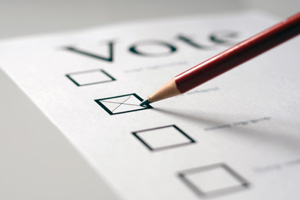
Thursday October 22, 2020 | VICTORIA, BC [Updated at 2 pm October 22, 2020]
by Mary P Brooke, editor | Island Social Trends
Regardless of the composition of the next legislative assembly in BC, BC NDP Leader John Horgan said today that he is “always about going forward” and says “I think that’s where British Columbians want to go as well”.
The stakes are high in terms of numbers. Some seats could go Green after the 42nd BC General Election on October 24, effectively pulling away some of the progressive vote in ridings that have traditionally been NDP-orange. The BC Liberals also have stronghold ridings and voting sectors (particularly among larger business) upon which they can generally count for voter support.
CASA again or traditional minority:
Island Social Trends asked Horgan today how he will handle delivering a progressive government again for British Columbians. Back in 2017 he made the case to then-Lieutenant-Governor Judith Guichon that (given the strength of votes for BC Green Party candidates in addition to the NDP failing to achieve a full majority) that — overall — British Columbians voted collectively for a progressive government.
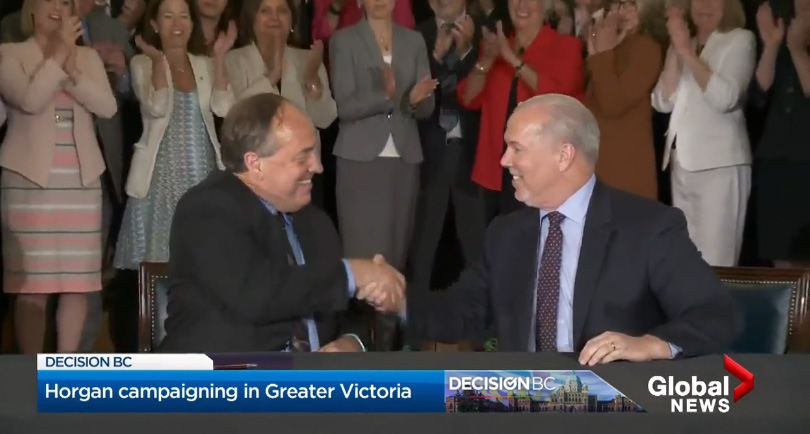
Based on that premise, the BC Liberals (who technically won a majority of the seats) were overturned by Guichon and John Horgan became premier based on a formal agreement with the Greens to form a stable government.
This time, would he aim for another Confidence and Supply Agreement (CASA) or operate with a traditional minority setup as we’re seeing in Ottawa where no one party has a majority of seats.
“What the legislature looks like after the election I’ll deal with at that time. But I think I’ve demonstrated to British Columbians that I’m prepared to work with anyone that wants to work with me, to bring forward changes that improve people’s lives and protect the services that they count on,” Horgan said in reply to the media query from Island Social Trends today.
Working further with the Greens:
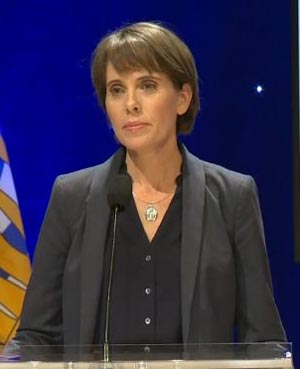
This time around, if the Greens siphon off some seats from the NDP, there could still be the larger view that BC voters will have chosen a progressive direction for governance.
To that point, Horgan responded: “We’ve made great progress over the past three-and-a-half years, working with the Green caucus. Dr Weaver stepped away from that caucus. He had family issues that he needed to deal with and he’s now left politics.”
“So the situation we had in 2017 is not the situation we have today,” Horgan continued. “The challenges that British Columbians face are not for the next few months but for the next few years. I’m hopeful that we can have a stable government going forward to address people’s concerns every single day.”
Throughout most of this 2020 election campaign, Horgan has said he will work cooperatively with the BC Greens and their new leader Sonia Furstenau (she was a sitting MLA during 2017-2020 but became leader only one week before this current provincial election).
Seasoned leadership:
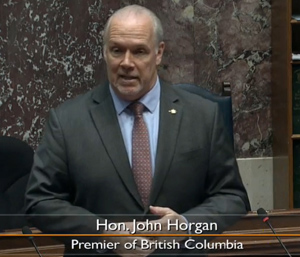
In all of this is some nuanced complexity about governance that is always easily expressed in a 10-second sound bite. For example “changes to improve people’s lives” might sound just like handouts (that the BC Liberals often indicate are too much or too costly), but to “protect the services that they count on” indicates knowing how complex the legislation, programs and policy strategies are for pinning together the complex range of services to the population.
As well, it’s interesting to see Horgan’s assessment of personalities or individuals in politics versus the directions or policies of a party. He had given great weight to the agreement he made with then-BC Green Leader Andrew Weaver, indicating many times that without Weaver the relationship with the Greens was very different, even unreliable. In hindsight we may see that Weaver’s departure was actually Horgan’s key tipping point for calling an election one year ahead of schedule (precipitated further by the sheer load of change and budget-demand of the pandemic).
A subtext to that is something we may not want to speculate about — was an agreement with a fellow male politician of about the same age and background more conducive to trust in the Greens at the time, and when the Greens found a new leader who is female and a bit more fiesty about a range of policy directions, that that was somehow less familiar or comfortable for Horgan who himself only recently has articulated about recently coming to terms with his own possible bias about gender and racial inequities.
Getting out to vote:
Horgan wants to make sure the NDP message is getting out “as far and as wide as possible”.
Pushing for votes in these last three days of voting, BC NDP Leader John Horgan today was able to articulate the NDP platform about working for everyday people, but didn’t really answer Island Social Trends‘ question about what would bring an undecided voter out to vote if they haven’t already.

Voting on General Election Day on Saturday October 24 will be “safe, easy and people can do it quickly on Saturday, as their last chance to have their say”. Horgan says he feels “British Columbians will take steps to protect themselves.”
As pointed out by Island Social Trends in our question to Horgan today, voting is also available in person today October 22 and Friday October 23 at any local District Electoral Office, from 9 am to 5 pm. To that, Horgan added that mail-in ballots can also be taken to DEO locations and to Voting Places “to be dropped into the box” on October 24. | Elections BC website
Voter turnout so far, and expected:
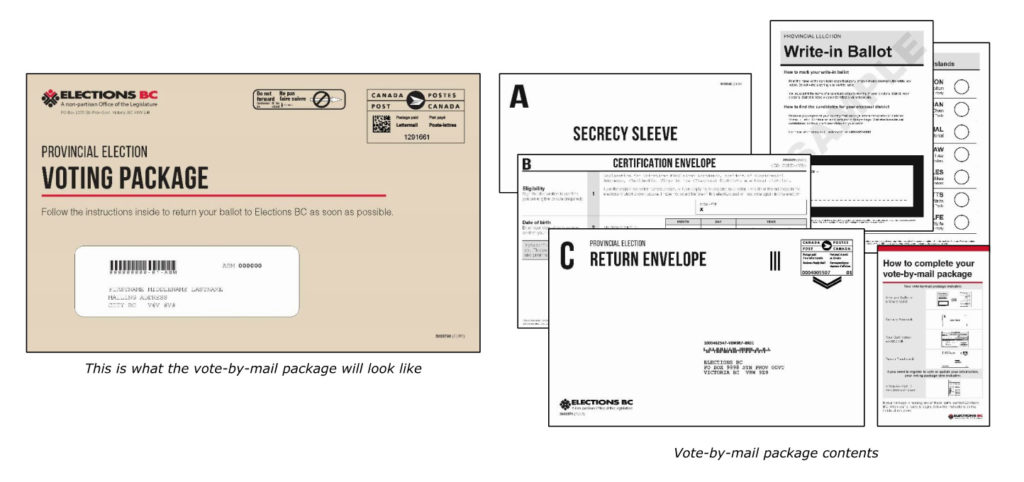
“Already a million people have voted, and that’s incredible. I don’t think we’ve seen numbers like that ever in BC,” said Horgan.
According to Elections BC, there are 3,485,858 registered voters in BC, and that 681,055 people voted in seven days of advance voting (October 15 to 21), or 19.5% of registered voters.
Combined with theoretically about 700,000 people voting-by-mail (that’s around how many mail-in packages were sent out upon voter request) that’s indeed 1,381,055 people (over 1.3 million) who will have voted ahead of general election day or 39.6% of registered voters.
By comparison, in the 2017 election in total for the whole election (including General Election Day), the voter turnout was 61.2%. So that still leaves around 21% of voters (i.e. 732,030 people) who might normally vote to make sure they do in the next three days.
Political pitches from all candidates and parties in these last three days are aiming for those 2,185,858 registered voters (if there were to be 100% turnout) who may yet show up to fill in a ballot. Or, if given the same 61.2% turnout as in 2017, that means another 1.3 million or so people will possibly or likely come out to vote today, tomorrow and Saturday.
“I’m hopeful people will vote for the BC NDP because we’re about making sure life’s better for people — investing in health care, building a British Columbia that includes everybody. I’ve been saying that for the past month and living that for most of my life, and I want to keep doing that in the years ahead,” said the BC NDP leader who will be premier, de facto, until final results of the election are known — possibly up to three weeks after October 24.
Mail-in and absentee ballots must be re-routed to each of the 87 District Electoral Offices around the province for counting in the local riding. By current legislation, that can only be done starting 13 days after the general election day.
First COVID-19 outbreak in a school:

Asked today by media about the first COVID-19 outbreak in a school in BC (a French school in Kelowna, reported by the BC Centre for Disease Control on October 21), Horgan said Provincial Health Officer Dr Bonnie Henry would be addressing that at 3 pm today in her media availability.
Three people in the school tested positive for COVID-19 and 160 people were asked to self-isolate and watch for symtoms.
Wearing masks for COVID-19 management:
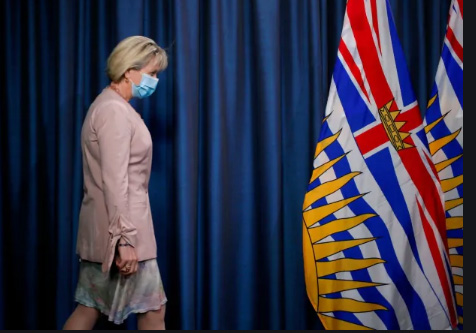
“Our plan will also be a flexible plan, amended as circumstances present themselves (re school outbreak). No issue is too small to address to reduce anxieties for families to get the best education for kids,” said Horgan today.
As for wearing masks during the pandemic to help slow down viral transmission, Horgan said that anything made mandatory “requires enforcement and leads to resistance and hostility”. That means he is very much on the same page as Dr Henry and her team around educating the public around the recommended public health measures about preventing the spread of COVID-19 unotl such time as there is a vaccine or a cure.




